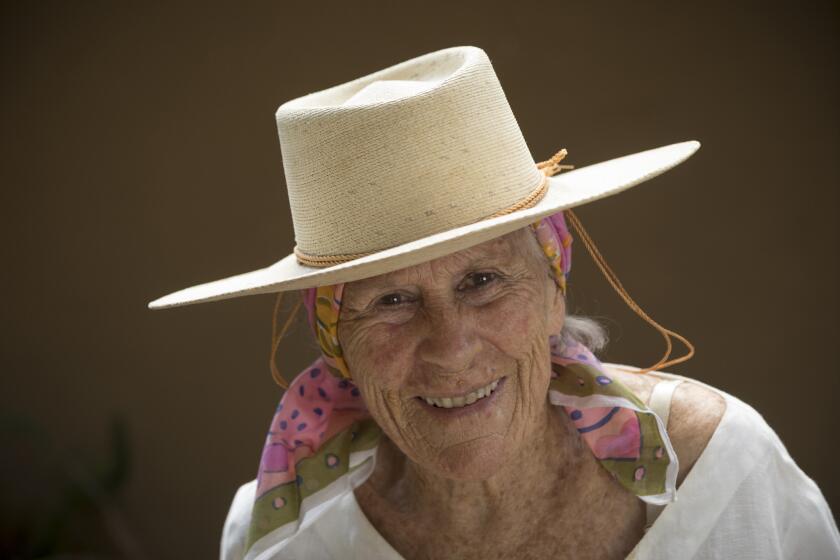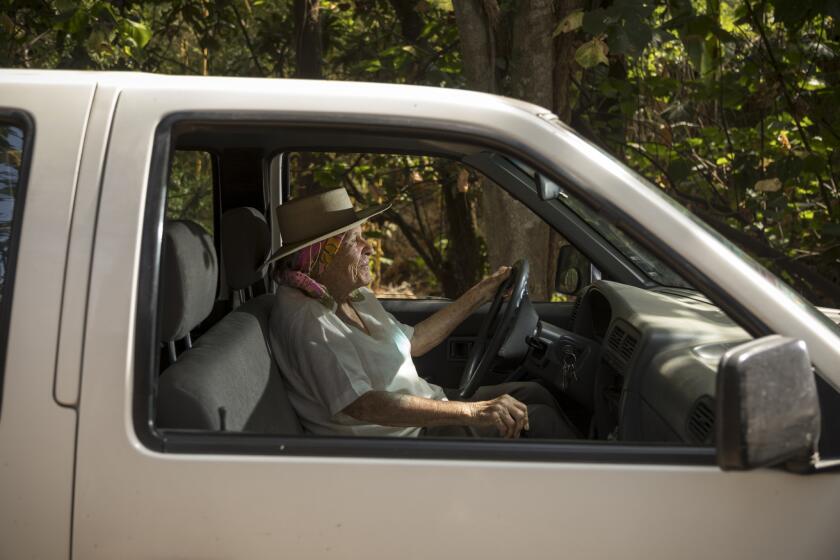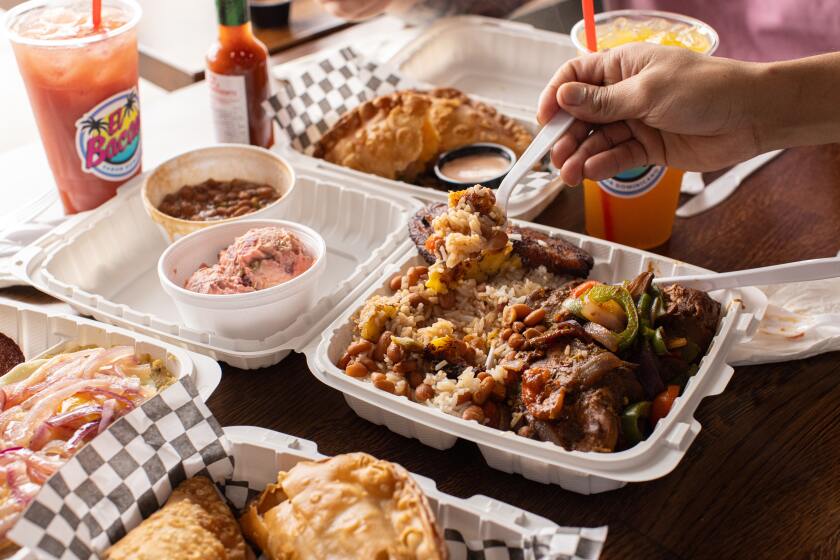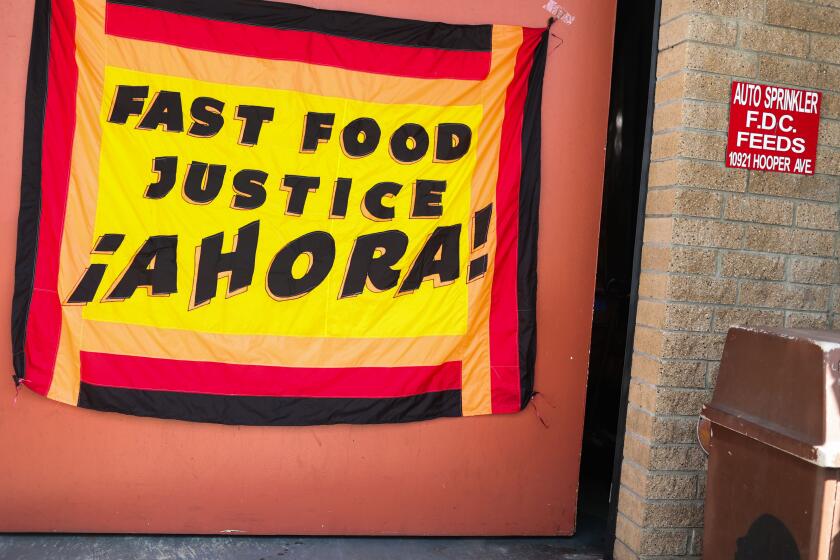Diana Kennedy: Rebel With a Cause
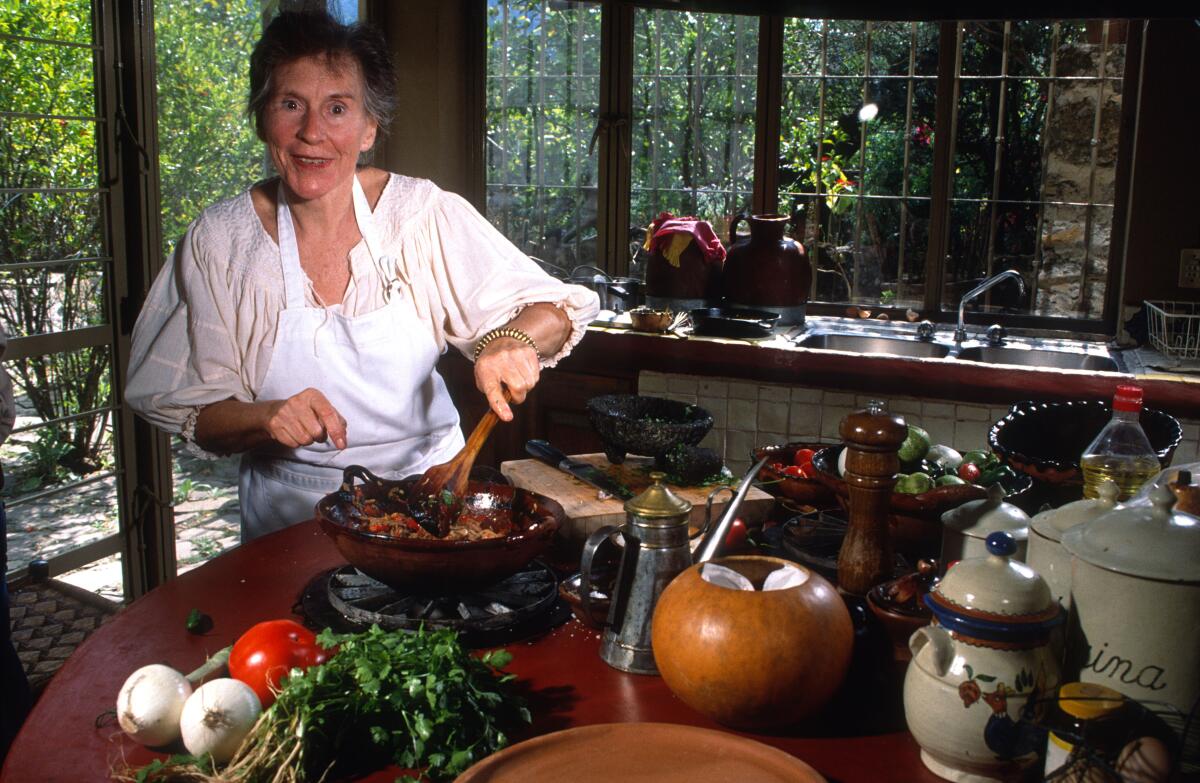
If her enthusiasm were not beautiful, it would border on mania.
—Craig Claiborne on Diana Kennedy, “Cuisines of Mexico”
Diana Kennedy, the doyenne of Mexican cuisine, is making dinner for 300 on this last day of September and things are not going well. First, the produce showed up two hours late, forcing Kennedy to play catch-up all morning. And the Englishwoman, who won’t discuss her age, has been having a devil of a time trying to teach her Mexican crew to make . . . tamales.
Tidy piles of fresh, washed vegetables and bowlfuls of ready ingredients occupy almost every work surface in the kitchen at Cafe Berlin, a lunch spot and catering operation at a warehouse complex of loft spaces for artists, located just north of downtown Los Angeles. This is the prep site for the following night’s dinner at Campanile restaurant, part of Kennedy’s two-week tour in conjunction with Los Angeles’ arts and cultural celebration, “Mexico: A Work of Art.”
“If you haven’t got an opinion,” Diana Kennedy says, “you aren’t a very good cook anyway.”
There are carrots and onions, zucchini and cauliflower, garlic, red potatoes, a bowlful of masa , a batch of freshly made salsa verde , a container of pinkish-brown dried shrimp. Her crew of prep cooks and volunteers work at slicing chiles and peeling onions.
Kennedy cuts a few pieces of cauliflower into florets, tosses them into a big stainless-steel bowl filled with a growing mountain of the vegetable, and then turns her attention to a bowl of zucchini flowers that have been presented for her inspection.
“Oh no, dearie,” she says to Kristen West, co-owner of Cafe Berlin and, for today, Kennedy’s sous chef, “these are female flowers.” In her book, “The Art of Mexican Cooking,” Kennedy is adamant that her readers use only male squash blossoms, but today the females will have to do.
“We aren’t in Dianaland,” says West.
Testy and uncompromising, she drove her truck across Mexico for decades, collecting and preserving regional ingredients and recipes.
Next, Kennedy is off to the stove, where she peeks over the shoulder of a cook sauteing carrots in a big cast-iron pan for tomorrow night’s pre-appetizer, vegetables in escabeche. On another burner he’s got a batch of small, whole white onions going.
“How are we doing?” she says in Spanish. “Bien ?”
Without pausing, a long-handled spoon in each fist, the cook nods and smiles.
“All right,” she says. “ Que bueno ! Now, let’s get those tamales going!”
She turns and walks in her characteristic shuffle to an industrial-sized mixer. In go a few pounds of masa , a mass of lard, some chicken broth, a little salt, some fresh epazote (her favorite herb), the zucchini flowers and chiles serranos . She scrunches her nose. “People are so hyper about lard,” she says.
As the mixer blade wiggles through the masa , Kennedy gradually adds a bowlful of corn kernels. Dressed in clean, white jeans, with her shirt-sleeves rolled just below the elbows and her hair tucke
d inside a crisp, white cotton scarf, Kennedy peers intently through the dark-rimmed glasses that rest just below the bridge of her nose.
“I’m not sure the masa is right,” she says. Twenty years after the publication of “Cuisines of Mexico,” the cookbook that established her reputation, Kennedy still worries that people won’t like her food.
Kennedy isn’t shy, however, about her role in changing Americans’ ideas about Mexican food. “I was the first one to get people going,” she says with her usual frankness.
“I mean, things were basically horrible then. The food you’d read about or eat in restaurants — well, there was nothing subtle about it. Everything was fried, and you couldn’t discriminate between the flavors or textures from one dish to the next. With my first book, I wanted people to learn about the wonderful things.”
“Cuisines of Mexico” was full of wonderful foods that mainstream America had never heard of: Yucatecan panuchos , or small tortillas filled with spice-rubbed pork and beans; duck in green pumpkin-seed mole ; pungent rabbit en adobo . In the English-speaking world, “Cuisines” was quickly recognized as the definitive Mexican cookbook.
“But I might tell you,” she says, scraping out the last of the corn, “it was a battle to get what I wanted. Nobody thought the book would sell. And I always remember when the then-art director of Harper & Row sent a little thing down for the cover with a sort of sombrero sitting on a cactus . . . I exploded! My editor, who is a very wise person, said, ‘OK, Diana, let’s invite them to lunch. We’ll give them a great meal and lots of margaritas — and after the meal, they’ll say, ‘Give her what she wants.’ ” She growls this last phrase, her imitation of a stubborn man grudgingly giving in to woman. Then she giggles. “Well, I ended up with a great designer.”
In “Nothing Fancy,” which premieres virtually Friday, the queen of Mexican regional cooking confronts mortality and the director of her documentary.
And she went on to write four more cookbooks, each but one focusing exclusively on Mexican cuisine. A revised version of her second book, “The Tortilla Book,” was recently released in paperback, and a sixth book is on the way.
At the moment, Kennedy has tamale problems. She takes a corn husk and places it in one hand, then spoons a bit of the finished masa in the center of the ready husk, neatly folds the package into a compact envelope, and ties it with a thin strip of husk, just as the illustrations in “Cuisines” direct. “See?” she says to her two young Mexican helpers, “ Bonito !”
“But this is the way we do it in Mexico,” says one of her young Mexican assistants, who only wants to make things easier for the nice lady. He slathers masa on the husk, quickly folds in the middle edges and tucks just one end over, leaving an opening on the other side where the filling might potentially escape.
“Ah,” she says, “but this is the way we do it in my part of Mexico.” She assembles a couple more tamales in her way; the helpers assemble a couple more . . . in theirs .
Kennedy screams.
“The baking powder! I knew I forgot something!”
She and her two helpers unwrap the tamales they’d assembled and the masa goes back in the mixer. As the mixer runs, she rolls her eyes skyward and spreads her hands out, as if pleading to God.
“Oh, I know I look as if I’m disorganized,” she explains, then taps her temple. “But I have a computer in here when it comes to cooking.”
In her book, “Nothing Fancy,” Kennedy wrote: “The more you cook, the less confident you are that things will turn out perfectly — adequately, perhaps — but then, perfection is rare because it is all tied up with you and the elements, that unfathomable alchemy which the slightest change in moisture, wind or phase of moon can upset.”
At the same time, Kennedy feels it is every cook’s responsibility to make the best meal within his or her power. For those who would try Kennedy’s recipes, that means searching out difficult ingredients — the Mexican herb hoja santa for green Oaxacan mole or chiles habaneros for fiery Yucatecan salsa. It means reading not just the recipe for a specific dish, but appendixes and notes on ingredients and cooking methods.
“Don’t just open the book for the first time as you light the stove,” she scolds the potential cook in “Mexican Regional Cooking.” “For this, with its strong peasant roots, is the haute cuisine of Mexico, and as much time and trouble should go into its preparation as into that of any intricate French dish.”
It’s not always easy to get this message across to her cooking students, who mostly worry about their diets.
“I think she’s added much more cheese than the recipe calls for,” whispers a petite, well-dressed woman in the middle of a Sunday-afternoon class with Kennedy.
“Good thing I go to the gym,” says her friend.
“Omigod!” says the first woman. “Now look what she’s going to do!”
Her friend buries her face in her hands, anticipating the onslaught of creme fraiche .
“Well,” says another woman smugly, “I walked 11 miles this morning — did it in two hours and 15 minutes.”
Kennedy knows the effect she’s having and seems to enjoy it. “The health people are so neurotic about everything,” she complains as she puts her smothered chiles rellenos in the oven. “If I had my way, I’d add a nice dollop or two of chicken fat.”
A few minutes later, Kennedy tweaks the other phobia of her average student: chile peppers. As a blender purees a bright green serrano-chile sauce, she tosses in five extra peppers, to the gasps of her students. “Oh,” she says, dismissing their objections. “It’s Sunday, you’ll all leave with a nice glow!”
By the end of the class, Kennedy has charmed the room. She’s funny and lively, and most important, her food is delicious.
“It’s difficult to educate a whole public,” Kennedy says. “Americans were raised to expect that horrible combination plate — the quick, cheap fix.”
She understands that a cooking student may simply be unaware of the possibilities of real Mexican cuisine — that it’s not inherently fattening, that it doesn’t all taste the same. That’s why she loves to teach. Twice a year, she hosts a small group of students at Quinta Diana, her wild ecological home in Michoacan that confuses her neighbors but is almost totally self-sufficent.
“I want to scream,” she says, “when food is not honest. When it’s high-priced and you know the owner doesn’t care. They think that we don’t know. . . .
“Then there are all these young chefs throwing things together that don’t really go together. Fancy Southwestern food, Tex-Mex — there are a lot of mismatches.”
She sighs. “I know, I know, I’m one of those rebel types.” Her cause: the preservation of the traditional Mexican kitchen. “It’s part of my mission,” she says.
When she fires up the mostly white, well-to-do audiences that fill her cooking classes, she slips into her role as agent provocateur for a cuisine that has few charismatic spokespersons in this country. But it’s her work in Mexico that is closest to her heart: exploring a remote village, talking with a talented cook, finding a new herb indigenous to just one tiny area.
“It’s almost like solving a crime,” she says. “You go around like a policeman. Sometimes the clues lead nowhere, but there’s always something surprising to learn. It’s still so exciting.”
When Kennedy first came to Mexico, she had no idea its food would become her life’s work. Raised in a middle-class home on the outskirts of London, Kennedy felt the urge to explore the world at an early age. Before she married, she served in the Women’s Timber Corps during World War II and traveled through Europe, the U.S., Canada and the Caribbean. In Haiti, she met her husband and true love, Paul Kennedy, the Mexico City correspondent for the New York Times.
She moved to Mexico, and was immediately struck by the country’s food and culture. “There were the marvelous markets, the wonderful colors, the exotic surroundings. I was always an adventurer, you see.” Eager to learn everything about her new home, Kennedy started hanging around the kitchen, asking questions of the maids who worked for her. She learned to make tamales, albondigas soup and gorditas from recipes that had been passed down orally through several generations.
When Craig Claiborne, then restaurant critic and food news editor for the New York Times, came to Mexico City, he paid the Kennedys a visit. Diana cooked and Claiborne was impressed. “I was crazy about her food,” he remembers. “And she seemed to have an encyclopedic knowledge.”
As the Kennedy legend has it, when Diana offered to buy Claiborne a Mexican cookbook to remember his visit, Claiborne uttered the idle remark that launched a career: “I’ll wait for the genuine article,” he said. “The day you publish one.”
Paul Kennedy died of cancer before she could begin.
In her most personal book, “Nothing Fancy,” Kennedy writes of their last trip from Mexico to New York.
“We were in a motel room somewhere in Texas. Paul laid his knife and fork down soon after he had started his meal. ‘I don’t know whether to thank you or not,’ he bellowed. ‘Most of my life I could eat anything anywhere, but now look what you have done to me. This damned rubbish . . . ‘ With that he pushed his plate back in disgust.”
Manchamantel, or “tablecloth stainer,” is a chicken, pork and fruit stew that Kennedy says was traditionally made on Corpus Christi day. Many versions of the recipe exist, but this one, from “Mexican Regional Cooking,” is Kennedy’s favorite.
MANCHAMANTEL (Chicken and Pork Stewed with Fruit)
3/4 pound boneless stewing pork, cut into 1 1/2-inch cubes
Salt
1/4 cup safflower oil or pork lard
1 (3 1/2-pound) chicken, cut into serving pieces
25 almonds, unpeeled
1 1/2-inch long stick cinnamon
1 1/2 tablespoons sesame seeds
5 dried ancho chiles, wiped clean and cleaned of veins and seeds
2 medium tomatoes, broiled
2 thick slices fresh pineapple, peeled and cut into 1x1/2-inch slices
1 (3/4-pound) plantain, peeled and cut into thick rounds
1 (3/4-pound) jicama, peeled, halved and cut into 1/4-inch-thick slices
Corn tortillas
Place pork cubes in saucepan. Add water to cover and salt to taste. Bring to simmer. Cover and simmer 15 to 20 minutes. Drain, reserving broth. Strain broth and skim off fat. Add enough water to broth to make 4 cups.
Heat safflower oil in heavy, heat-proof casserole. Saute chicken pieces lightly, few pieces at a time. Remove chicken and set aside.
Reheat drippings in casserole and fry almonds, cinnamon stick and sesame seeds separately, draining and adding each to blender jar.
Reheat same drippings and fry chiles lightly on both sides. Drain and add to blender jar with broiled tomatoes and 1 to 1 1/2 cups broth. Blend mixture until smooth. (Be careful to add only enough broth to release blades of blender. Sauce must not be too watery.)
Pour off all but 3 tablespoons drippings remaining in casserole and fry chile sauce about 4 minutes, stirring and scraping bottom constantly. Add 3 cups of reserved broth and bring to simmer. Add chicken pieces, pork cubes, pineapple, plantain and jicama. Season to taste with salt. Cover and cook over low heat 1 to 1 1/4 hours, or until meat and fruit are tender, stirring occasionally. Serve hot with freshly made tortillas. Makes 6 servings.
Each serving contains about:
463 calories; 118 mg sodium; 107 mg cholesterol; 29 grams fat; 34 grams carbohydrates; 21 grams protein; 2.2 grams fiber; 56% calories from fat.
The original version of this recipe comes from Angel Delgado, the owner of Las Diligencias in Tampico. In uncharacteristic nod to the health establishment, Kennedy slightly altered the recipe for “Mexican Regional Cooking” by reducing the amount of butter (“the sour cream is quite rich enough, she says) and using shrimp broth instead of milk in the sauce. “Never serve it on top of rice,” she says, “or all that lovely sauce will be sopped up and lost.”
CAMARONES EN PIPIAN (Shrimp in Pumpkin Seed Sauce)
1 1/2 pounds medium shrimp, unshelled
2 1/2 cups cold water, about
1 teaspoon salt or to taste
Freshly ground pepper
1 cup unroasted, unsalted, hulled pumpkin seeds
8 sprigs cilantro
3 serrano chiles or any fresh hot green chiles, wiped clean
1/2 small white onion
1 tablespoon unsalted butter
2/3 cup sour cream
Shell and devein shrimp and set aside.
Put shells, tails and heads if any, into saucepan. Add water with salt to taste and cook over medium heat about 20 minutes to extract flavor and make light broth. Strain and discard shells, reserving cooking liquid. Cool slightly. Add shrimp and cook over heat about 3 minutes or until just turning opaque. Drain shrimp, reserving broth.
Toast pumpkin seeds lightly in heavy ungreased skillet, stirring frequently, until they begin to swell and start to pop about. Do not let brown. Cool, then grind finely in spice grinder. (Alternatively, add to blender with broth in next step, but sauce will not be smooth.)
Place shrimp broth, pumpkin seeds, cilantro, chiles and onion in blender or food processor. Blend until smooth.
Melt butter in heavy saucepan. Add blended pumpkin seed sauce and cook over very low heat, stirring and scraping bottom of pan constantly, about 10 minutes. Add shrimp and heat through another 5 minutes. Sauce should be of medium consistency. Makes 6 servings.
Each serving contains about:
301 calories; 664 mg sodium; 236 mg cholesterol; 17 grams fat; 8 grams carbohydrates; 31 grams protein; 1 gram fiber; 51% calories from fat.
Though it’s not as common as rice, pasta is a part of Mexican cooking. This is one of the simplest and most comforting. From “The Art of Mexican Cooking,” it’s a good recipe for the Diana Kennedy novice.
PASTA SOPA DE ESPAGUETIS CON QUESO Y CREMA (Spaghetti With Cheese and Cream)
2 quarts water
1/4 small white onion
1 garlic clove, peeled
1 small bay leaf
Dash dried oregano, Mexican preferred
1 tablespoon safflower oil
Sea salt
6 ounces spaghetti
2 tablespoons unsalted butter
1 cup creme fraiche
2 to 3 ounces queso fresco, queso manchego or medium-sharp Cheddar cheese
Place water in saucepan and add onion, garlic, bay leaf, oregano, safflower oil and sea salt to taste. Bring to boil and add spaghetti. Cook over high heat until pasta is tender--not al dente. Strain, discard cooking water, rinse pasta in cold water, drain and set aside.
Melt butter in deep fryer or saute pan. Stir in cooked pasta and heat through, turning over thoroughly.
Add creme fraiche and salt to taste and heat through over low heat, about 3 minutes. Add cheese, stir once and serve immediately. Makes 4 servings.
Each serving contains about:
385 calories; 190 mg sodium; 118 mg cholesterol; 34 grams fat; 15 grams carbohydrates; 7 grams protein; 0 fiber; 79% calories from fat.
In Mexico, cherimoyas (chirimoyas in Mexican usage) are usually peeled and eaten raw. But, as Kennedy says in “The Art of Mexican Cooking,” they make an interesting ice, as well. The texture resembles a smooth applesauce, which needs no cream or thickeners. Lime juice brings out the flavor. (Two pounds of cherimoya will render approximately 1 1/4 cups pulp when cleaned and seeded.)
HELADO DE CHIRIMOYA (Cherimoya Ice)
2 pounds ripe cherimoyas
1 rounded tablespoon sugar
1/3 cup water
1 tablespoon fresh lime juice
1/4 teaspoon finely grated lime zest
Rinse and dry cherimoyas. Break open vertically and scrape flesh from thin skin. (If flesh is beginning to turn brown just under skin, do not scrape off that part as it tends to be tough and grainy and will spoil flavor of fruit.) Remove seeds and blend pulp in food processor until smooth. Stir sugar into water until dissolved. Combine with cherimoyas, lime juice and zest. Freeze in ice cream machine following manufacturer’s directions.
Once ice is finished, pack into containers and store in freezer section of refrigerator. Leave to ripen at least 24 hours before using. Remove from freezer at least 20 minutes before serving (unless you live in very hot climate). Makes about 2 1/2 cups, or 8 servings.
Each serving contains about:
113 calories; 0 sodium; 0 cholesterol; 0 fat; 29 grams carbohydrates; 1 gram protein; 2.5 grams fiber; 4% calories from fat.
This recipe, from “Cuisines of Mexico,” is a project. Like a lot of Kennedy recipes, there are loads of sub-recipes and plenty of prep work. She means it when she tells potential cooks to read her recipes and all their supplemental information before you start to cook.
But the Garnachas--Yucatecan tartlets of fried masa filled with black bean paste and ground beef, covered with tomato sauce and sprinkled with cheese--do make good appetizers. And much of the work can be done ahead. The picadillo, bean paste and tomato sauce work well with other dishes and they freeze perfectly well, so you could always keep some on hand. Once fried, however, the garnachas should be served immediately, otherwise they will become leathery.
GARNACHAS YUCATECAS (Yucatecan Black Bean and Beef Tartlets)
2 cups masa harina
1 1/4 cups cold water
1/4 teaspoon salt
Lard, melted or oil
1 cup Frijoles Colados y Refritos a la Yucateca, warmed
1 cup Picadillo Sencillo, warmed
1/2 cup Salsa de Jitomate Yucateca, warmed
3 tablespoons queso seco, finely grated, or Romano
Mix masa harina, cold water and salt together to form soft dough. Roll dough into 12 balls, each roughly 1 3/4 inches in diameter.
Press ball of dough onto floured surface and make well in center with both thumbs together. Press out sides of well and mold dough into small basket shape, about 3 inches across and 3/4-inch deep. Dough should be about 3/4-inch thick. Repeat process for remaining dough balls.
Pour 3/4-inch deep melted lard into small skillet. Heat to smoking and fry garnachas, hollow-side down first, until pale gold and barely crisp on outside. Drain on paper towels and keep warm.
Fill half of each garnacha with 1 tablespoon Frijoles Colados and other half with scant tablespoon Picadillo Sencillo. Cover top of filling with 1 large teaspoon Salsa de Jitomate Yucateca and sprinkle with queso seco. Serve immediately. Makes 12 Garnachas.
Note: Garnachas can be prepared to point of frying hours ahead. Keep covered to prevent masa from drying.
Picadillo Sencillo (Ground Meat Filling)
1 tablespoon lard
1 clove garlic, finely chopped
1/2 medium onion, finely chopped
2 medium tomatoes (about 3/4 pound), skinned, seeded, and finely chopped
1 pound ground beef
1/2 teaspoon salt or to taste
Freshly ground pepper
Melt lard in skillet over medium heat. Saute garlic and onion until tender (do not brown). Add tomatoes and saute about 1 minute more.
Add ground meat and season to taste with salt and pepper. Cook over medium heat until tender. Makes about 2 1/2 cups.
Frijoles Colados y Refritos a la Yucateca (Yucatecan Sieved and Fried Beans)
1 pound black turtle beans
10 cups hot water
1/4 white onion, roughly sliced
5 tablespoons lard
1 tablespoon salt, or to taste
2 large sprigs epazote
1/4 medium onion, roughly sliced
1 chile habanero
Rinse beans and run through hands to remove any small stones or bits of earth. Place beans in earthenware bean pot and cover with hot water. Add onion and 2 tablespoons lard. Bring to boil.
Quickly reduce heat and barely simmer, covered, about 3 hours, or until just tender but not mushy. Do not stir.
Add salt and epazote and simmer another 30 minutes. Set aside, preferably until next day. There should be plenty soupy liquid. Reserve 1/2 frijoles for another use.
Pass remaining beans with bean broth, about 3 1/2 to 4 cups, through medium disk of food mill. Melt 3 tablespoons lard in large skillet pan. Add and saute onion until tender.
Add sieved beans and chile habanero. Cook over high heat to soft paste, about 15 minutes.
Salsa de Jitomate Yucateca (Yucatecan Tomato Sauce)
3 medium tomatoes (1 pound), broiled
2 tablespoons peanut or safflower oil
1/4 medium onion, finely chopped
1/4 teaspoon salt
1 chile habanero, lightly charred
Remove any blackened pieces of skin from tomatoes and mash roughly with mortar and pestle.
Heat oil in small skillet over medium heat. Add and saute onion until tender. Add mashed tomatoes, salt and chile habanero. Cook about 8 minutes until sauce reduces and thickens.
More to Read
Eat your way across L.A.
Get our weekly Tasting Notes newsletter for reviews, news and more.
You may occasionally receive promotional content from the Los Angeles Times.
